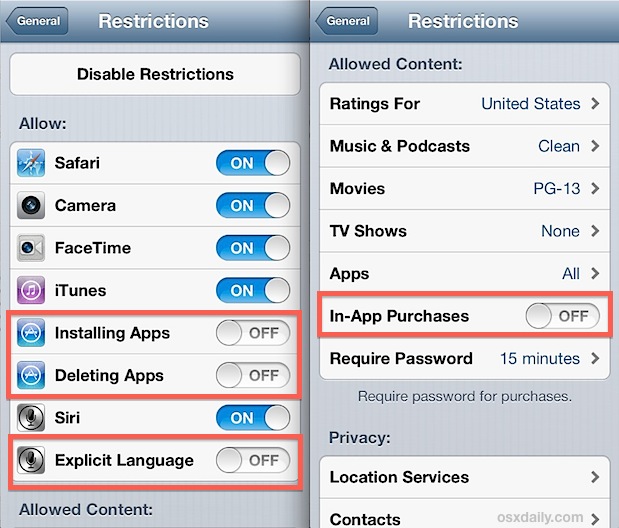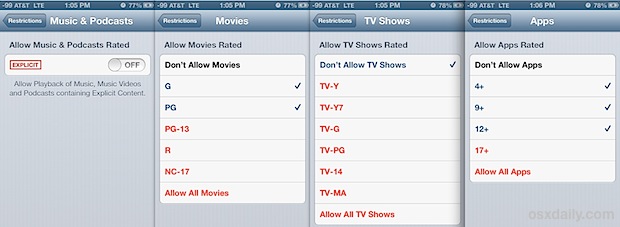
If you plan on giving an iPhone, iPad, or iPod touch to a child, take a moment to set up some very basic parental controls on the device by using the Restrictions feature of iOS. It only takes a minute to configure, and this will prevent the access of inappropriate content, avoid mature themed media, prevent in-app purchases and incidental charges, disable the ability to download and install new apps, plus prevent the removal of apps that have already been installed on the device.
Prevent Installing & Deleting Apps, In-App Purchases
Open Settings and go to “General”, then to “Restrictions”
Tap “Enable Restrictions” and set a passcode to control access to the restrictions panel
Under ‘Allow’, toggle the following to OFF: “Installing Apps”, “Deleting Apps”, “Explicit Language”, and adjust other apps and settings as necessary
Scroll down to “Allowed Content” and flip “In-App Purchases” to OFF
Restrict Inappropriate Content by Age Rating
Still within the “Restrictions” settings, look under ‘Allowed Content’ and tap on “Music & Podcasts” and turn Explicit to OFF
Toggle “Movies” and “TV Shows” to age appropriate settings (G and PG are perhaps most common, or consider turning the feature off completely)
Go to “Apps” and choose age appropriate settings, note that some standard apps like third party web browsers may be rated as “17+” because they could be theoretically used to access adult content
The screen shots below demonstrate this on an iPhone, with some of the most important restriction features enabled. If nothing else, turning off in-app purchases, app downloads, and
app removal in general are highly recommended.

Content restrictions can be defined by age to determine what is appropriate and what is not, this will impact what type of media can be viewed on the device:

Optionally, you may want to adjust Location Settings as well, though it’s best to be targeted with this and turn off geotagging with apps like camera and photos. Turning off all Locational functionality is often undesirable because it prevents the meaningful usage of apps like local encyclopedias, weather, maps, and those relentlessly fun and educational starry night apps.
 These options are the same in practically all versions of iOS, though you will find past versions of iOS may label the Restrictions settings as “Parental Controls” instead. Additionally, iOS 7 includes an option to limit certain web content by age level as well.
These options are the same in practically all versions of iOS, though you will find past versions of iOS may label the Restrictions settings as “Parental Controls” instead. Additionally, iOS 7 includes an option to limit certain web content by age level as well.
Going further, you can also hide unwanted apps like Safari, App Store, iTunes, iBooks, FaceTime, or going so far as turning off all third party apps, and even disable the camera if you don’t want it to be used at all.
Finally, there’s the option of using Guided Access to lock an iPhone, iPad, or iPod touch into a single application and prevent it from being quit. We like to refer to Guided Access as Kid Mode because it’s incredibly effective at keeping even the most curious youngsters from accidentally exiting out of an app or doing something undesirable on the device, and it can make for an excellent quick way to hand an iOS device off to a young one without worrying about accidental usage. Nonetheless, Guided Access is no replacement for using effective restrictions to prevent improper use of a device, and the features are best used separately with full understanding of their limitations and benefits.
These quick setup tips come to us from Mrs Anderson (thanks!), a teacher with a handful of iPod touches in their classroom. Obviously this is useful outside of educators as well, and many parents, grandparents, babysitters, brothers, sisters, just about anyone, should find some useful tricks here if they’re going to be sharing an iOS device with kids.